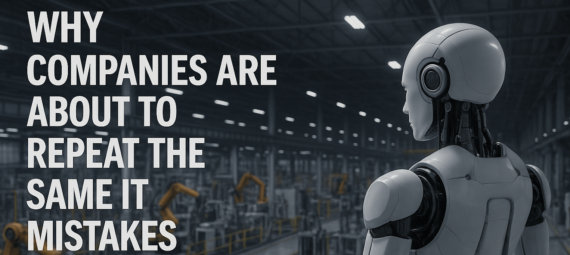Every few decades, technology rewrites the rules of business:
- The personal computer liberated work from the mainframe.
- Client-server architectures connected the enterprise.
- The internet opened the world and unleashed an information explosion we’re still trying to contain.
- Cloud computing democratized scale.
- Smartphones put information and intelligence in your hand.
Each time, we raced ahead and each time, we paid for it later.
In the rush to innovate, we created sprawling ecosystems of tools, data, and systems that promised speed but left behind a trail of technical debt. We learned (the hard way) that ungoverned freedom eventually becomes friction. Security gaps widened. Compliance teams scrambled. Integration costs ballooned.
Now, history is repeating itself only faster.
Across large organizations, AI is being hailed as the next great productivity engine. It’s designing new molecules, predicting maintenance failures, optimizing supply chains, and reinventing customer interactions. Boards are demanding AI strategies. Funding is flowing. Every function is experimenting.
And yet, beneath the excitement, a familiar problem is emerging.
The pattern we keep repeating
Every technology revolution begins with decentralization. Innovation happens at the edges, in labs, plants, and business units, where creativity thrives and governance hasn’t yet caught up.
But as adoption spreads, organizations discover they’ve created a patchwork of systems with no single owner, no shared data standards, and no common rules. The same story played out when the internet arrived and every department launched its own website; when cloud services bypassed IT; when mobile apps fragmented enterprise data; and when automation bots multiplied without oversight.
AI is following the same trajectory.
In many enterprises, hundreds of models, smart prompts, and agents are now running, some built by IT, others by individual departments or even vendors. Few are monitored. Fewer still are governed.
The result? Shadow AI, untracked, untested, and potentially unsafe.
What begins as innovation often ends in exposure: biased results, compliance breaches, and opaque decision chains that no one can fully explain.
Where the stakes are highest
For manufacturing and life sciences organizations, the implications go far beyond efficiency. These industries operate under the highest expectations of precision, traceability, and accountability. A single unvetted algorithm could misclassify a product defect, bias a clinical outcome, or automate a decision that violates regulatory standards.
Life Sciences
In life sciences, the risk isn’t just operational, it’s existential. AI outputs can directly influence research data, patient safety, and regulated processes. If those outputs aren’t transparent and validated, they can violate global regulations like FDA 21 CFR, EMA GxP, or ICH E6, triggering audits, fines, or product recalls.
A model that fails to document its data lineage, validation history, or decision logic doesn’t just fail compliance, it undermines trust. And in this sector, trust is currency.
Manufacturing
In manufacturing, the stakes are different but just as real. AI-driven automation in production, logistics, or quality control can dramatically increase efficiency, but when it goes wrong, it can disrupt entire supply chains or compromise product integrity.
Yet many organizations are already running dozens of uncoordinated AI initiatives across R&D, quality, and operations. Each uses different platforms, datasets, and governance approaches. None share a unified view of risk or performance.
It’s the same fragmentation we saw in every previous wave of technology, from the early internet and cloud sprawl to the smartphone and IoT booms, only now, the impact is amplified by automation, speed, and global scrutiny.
The risk isn’t that AI will fail. It’s that it will succeed wildly, without control.
From Experimentation to Maturity
There’s a growing recognition among forward-looking leaders that this moment demands more than innovation, it demands discipline. Not the kind that slows creativity, but the kind that makes it sustainable.
- AI maturity means having visibility, policy, and control across the entire AI landscape, from concept to production to retirement.
- It means knowing where every model lives, what data feeds it, who owns it, and how it performs.
- It means applying enterprise policies automatically, ensuring security, ethics, and compliance aren’t afterthoughts but embedded principles.
- It means automating risk and compliance checks, continuously monitoring for drift, bias, or regulatory impact before issues become incidents.
- It means managing the full lifecycle, governing not just how AI is deployed, but how it’s trained, validated, and eventually decommissioned.
And most importantly, it means aligning IT, security, compliance, and business leaders under a single, transparent framework.
This is the quiet revolution happening inside the most mature enterprises: they’re building Al control towers that turn experimentation into enterprise capability. They’re ensuring that every AI initiative, whether in a production line, a clinical trial, or a customer portal, is accountable, explainable, and compliant by design. Because at scale, visibility is the new currency of trust.
The real AI revolution
We’re witnessing the same energy and optimism that accompanied every major IT shift, but this time, the consequences of getting it wrong are bigger, faster, and more public. The true competitive edge won’t come from who adopts AI first, but from who adopts it wisely. From who can scale innovation responsibly, without sacrificing security, governance, or ethics. From who can prove, not just claim, that their AI is reliable, auditable, and aligned with the values and regulations of their industry.
For large organizations, that’s the next frontier. The organizations that treat AI governance as a strategic enabler, not a bureaucratic hurdle, will lead the next era of intelligent operations and digital trust. Because in the end, every IT revolution begins in chaos and ends in governance.
This time, we have the chance to start with both.

